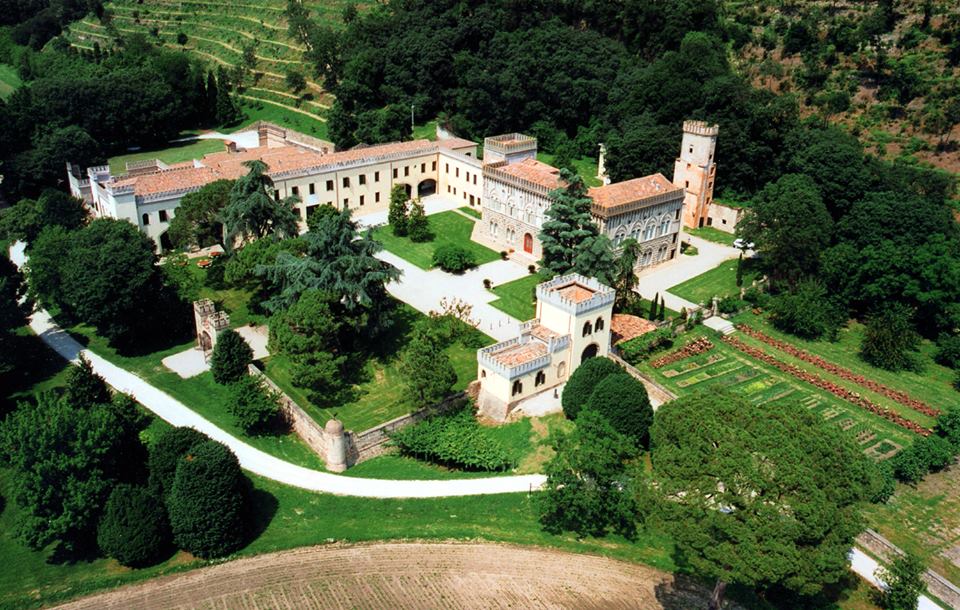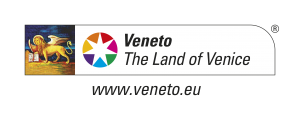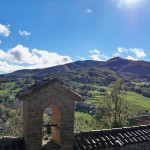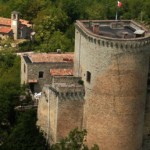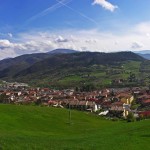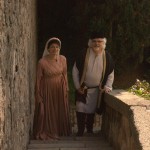At the centre of the 4 provinces: Pavia, Alessandria, Piacenza and Genoa
Monselice: Lispida Castle
Spend a night here and taste the great local “archaic” wine
The Lispida Castle, near to Monselice, looks like a castle of some fairy tale with its crenellated façade and the gothic windows! On the contrary, just the king-soldier Vittorio Emanuele III had lived here, it was his headquarter during the First World War. Maybe that is the reason why this place has survived almost intact to the war.
The history of Lispida Castle dates back to many years ago, to the Middle Age. By that time, here there was a monastery, popular thanks to its vineyards and its good wine. But at the end of the 15th century, Doge Mocenigo deprived the monks of this territory, because they weren’t so able to produce wine. During the 18th century the Corinaldi Family continued the tradition and the Castle turned into a typical Villa-farm, really popular for its wine again.
Today the young owner Alessandro welcomes us in the wine cellar to tell us about his innovative ideas… That are paradoxically a jump back into the past! Starting with the processes of farming Tocai and Merlot vineyards: no chemistry, no pesticide, no cutting down of the surrounding landscape. As anti-parasite therapy, he sprays propolis and attracts birds and bats who eat the insects! The vine growing is super-biological, but the method to produce wine is even archaic! After the pressing, Alessandro put the must and the peels into amphoras in the cellar. Here the wine ferments and then Alessandro can remove the peels and pour once again the wine into the amphoras for the ripening (8/10 months). That’s exactly the method used by the Mycenaeans! Basically, the wine of the Trojan War!
In the past to face both conservation and transport, the wine makers used to add some honey and spices to reduce the acidity, so that the archaic wine became (notoriously) disgusting. Today all these stuff are over, thanks to the modern bottles! The wine produced by Alessandro, preserved in a 3000-year-old amphora, is actually excellent!
For the record: tourists can sleep in the castle! The garden is beautiful, full of flowers, and there is also a pool… Don’t miss it!
⇒ Watch the full web serie Padua art & wellness slow tour Visit Lispida Castle official webisteVideo full text: Lispida Castle
We are the on the foothills of Monselice. This is Lispida Castle, right? It is a place steeped in history: from 1100 to 1150 it was an ancient monastery. In 1500 it was a farm villa. Victor Emmanuel III set up his headquarters here following the battle of Caporetto, as the First World War drew to a close. Alessandro has transformed this tradition into innovation, which has in turn seen a radical return to tradition. Beginning with the planting of the vineyard. Starting from the vine, it all looks a bit “untidy”. It’s all natural farming here, there’s no weeding and there are no chemicals. It’s left in a bit of a wild state? It is looked after, but delicately so. So what about pest control? One example is that we treat it four times a year with raw propolis produced by the bees, which produces a really interesting anti-mildew effect. It’s all natural, all super-organic. So then, after the vine there’s the winery, down there. Alessandro’s winery looks like a museum, and it is here that he has put together his mind-blowing idea! Speaking of Innovetion Valley, North-East, creativity and total innovations, Alessandro has found a way of producing wine using a method that is totally cutting edge. It’s innovation in reverse, an archaic wine, recreating it from its origins and producing it in these terracotta amphorae. Archaic wine means wine as it used to be made three to four thousand years ago, in terracotta amphorae buried in the cellar. Nowadays wine is technology and human intervention. Alessandro’s wine is the total opposite, it is innovation in reverse, in pursuit of naturalness. This terracotta implement allows the grape, which draws all of its substance from earth, to be born again in a recipient made precisely from earth. The grape starts to ferment in the amphorae for 6 months, then, at the spring equinox, the skins are removed, the amphora is washed and the wine is poured back into it again to mature for a further 8 months. But doesn’t wine turn acidic? It is well know that Etruscan wine was a bit disgusting. In ancient times wines were carried in transporting amphorae, of different shapes, with two handles and generally of 56 litres. They were transported in the holds of ship or on carts, which is why the wine became corrupted. To prevent this the wine was treated in advance using agents that could be considered the preservatives of our time: i.e. honey, cooked must, sea water and, in some cases, resins. This gave the wine a nasty taste. And what about now? We no longer have this problem, because we bottle it in normal bottles with corks. We can gather the best of the amphorae and transfer it to the dining table of the final customer! It’s true, it not acidic! So what does this wine have that makes it different from a normal wine? It is easily digestible, has no ill effects and it does not weigh heavy on you the next day. The best thing for innovation and for the future is to go back to the deepest past! It’s not that I want to support it at any cost, but it shows how it is possible to do this as well, to innovate in reverse. Slow Tour in Innovetion Valley, on the trail of Italian style creativity!Produced in cooperation with the Official Tourist Board
Visit Padua: helpful hints
Italian name: PadovaArrival
Padua doesn’t have an airport. The nearest airport for international flights is the Venice Airport, but there is a bus leading directly to Padua (rides every hour, 8,5€). For transcontinental flights the nearest airport is the Bologna Airport. From the airport, first you have to reach Bologna Central Station by bus (rides every 15 minutes, it takes 30 minuts, 6€). From Bologna Central Station, both Trenitalia and Italo trains reach Padua in 50 minutes (ticket 10€, more or less).
Transports
You can visit Padua on foot or by bus. Single ticket costs 1,3€ and it lasts 75 minutes, more on FBus website.What to do
Padua is a stunning art city in Veneto region, close to Venice and Verona, in North Eastern Italy. It is famous for several art masterpiece that you simply must visit: start with the Giotto’s Scrovegni Chapel and Saint’s Anthony church. The University of Padua is one of the oldest and most important in Italy and in the whole Europe, here taught none other than Galileo Galilei and you can still visit its original Podium.
For a special break, look for the historic Caffè Pedrocchi and ask for their fine special caffè (a long espresso coffee with fresh mint cream and chocolate powder).
For more tips, watch the whole web serie we made about Padua and if you are fond of SPA tourism (or you just need some relaxing quality time) consider to spend some time on the Colli Euganei area, nearby. Pick one of the several SPA resort and enjoy the Roman baths and muds (try Abano Terme or Montegrotto Terme). From Padua, you can also reach easily many other interesting places, take a look to this itinerary through the amazing Palladian Villas of Veneto.

